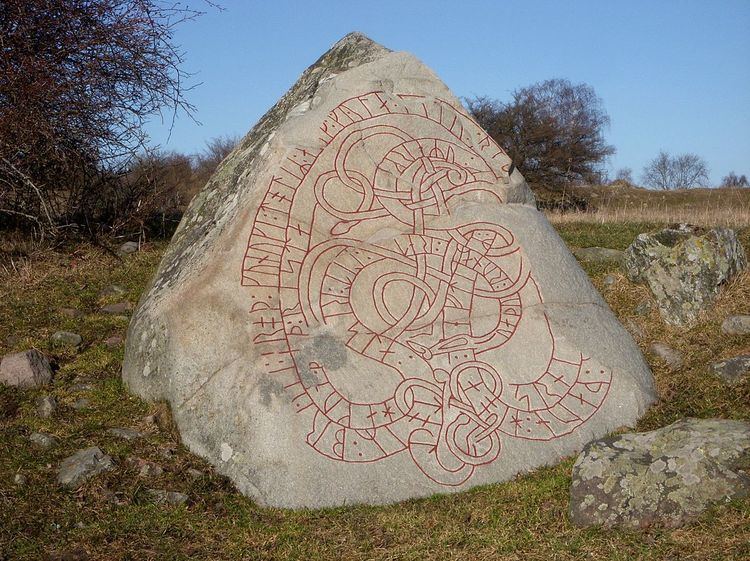Name Hakan Red Great-grandparents Ulf Tostesson Grandparents Ragnvald Ulfsson | Parents Stenkil Role King | |
 | ||
People also search for | ||
Håkan the Red (Swedish: Håkan Röde) was a king of Sweden, reigning for about a decade in the second half of the 11th century. There is little information on him, and it is mostly contradictory. Nothing is known about his reign.
Contents
Swedish historian Adolf Schück has asserted that, rather than Blot-Sweyn being an individual king, there are indications that that may have been another name for King Håkan.
His cognomen the Red comes from the regnal list of the Westrogothic law, written in early 13th century. The same source claims that he was born in Levene, in Västergötland.
Succession sequence
Despite contradiction in the sources, Håkan's position as a successor of Stenkil in the line of Swedish kings is generally accepted as correct. Perhaps he reigned from c. 1066/1070 in some areas of Sweden (succeeding Stenkil or Halsten Stenkilsson), and from c. 1075 in Uppland as well (succeeding Anund Gårdske). The regnal line in Nationalencyklopedin omits Anund Gårdske and presents Håkan as successor of Halsten Stenkilsson. Nationalencyclopedin also suggests that he may have ruled jointly with Inge the Elder in the 1080s. A papal letter from Gregory VII is addressed to Inge together with either Håkan or Halsten Stenkilsson as kings of the västgötar, ordering them to collect tithe and send priests to Rome to educate themselves.
According to Encyclopædia Britannica, "[a]t the end of the Viking Age [approximately 1050], Sweden remained a loose federation of provinces. The old family of kings died out in 1060; after the death of the last of these kings' son-in-law, Stenkil, in 1066, a civil war broke out. Around 1080 Stenkil's sons, Ingi and Halsten, ruled, [...]." If "civil war" is an appropriate characterisation of the period from 1066 to 1080, the rulers of that epoch would be in the grey area between "king" and "warlord". Describing this period for Sweden as a whole in a linear translatio imperii kind of regnal succession, can then only be achieved at least partially based on speculative historical reconstruction, which appears to have happened in diverging directions from the early 13th century on, at the latest.
Adam of Bremen
A scholion in Adam of Bremen's History of the Archbishops of Hamburg-Bremen (written 1070s–early 1080s) says that Håkan was elected king after Stenkil's son Halsten had been deposed, and after Anund Gårdske also had been rejected. At his enthronement he was obliged to "take the mother of young Olof in marriage". It is not clear from Adam's text what Olof is meant, but it has been suggested that he might be King Olav Kyrre of Norway, whose mother Tora Torbergsdatter was a cognatic descendant of the Norwegian branch of the Yngling dynasty. While this remains unproven, the marriage was probably a politically well-planned act to gain support for Håkan's rule.
Regnal list of the Westrogothic law
According to the regnal list of the Westrogothic law, Håkan the Red would have ruled 13 years, as Stenkil's predecessor. He was born in Levene in Viste Hundred in Västergötland, and was buried there after his demise. The Levene estate is also associated with King Stenkil, suggesting that Håkan might have sprung from the same kin group. Another Swedish king list from the 13th century has the sequence Stenkil - Halsten - Näskonung - Blot-Sweyn - Håkan the Red (Haquinus rufus) - Inge the Elder.
Sagas
In Magnus Barefoot's Saga, a part of Snorri Sturluson's Heimskringla (1225), he is given as the successor of Stenkil (who died in 1066):
Steinkel, the Swedish king, died about the same time as the two Haralds fell, and the king who came after him in Svithjod was called Håkan. Afterwards Inge, a son of Steinkel,
Similarly, in Hervarar saga (13th century):
Steinkel had a son called Ingi, who became King of Sweden after Håkan.
Runestone
Presumably it was Håkan the Red who ordered the carving of a runestone found in Hovgården (Adelsö island in Lake Mälaren, Uppland, Sweden). The Rundata catalog number of this runestone is U 11.
